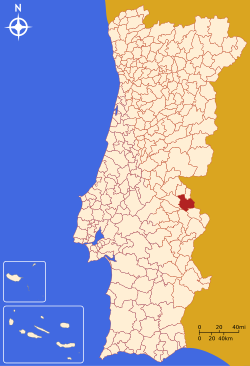Portalegre, Portugal
| Portalegre | |||
|---|---|---|---|
| Municipality | |||
 |
|||
|
|||
 |
|||
| Coordinates: 39°19′N 7°25′W / 39.317°N 7.417°WCoordinates: 39°19′N 7°25′W / 39.317°N 7.417°W | |||
| Country |
|
||
| Region | Alentejo | ||
| Subregion | Alto Alentejo | ||
| Intermunic. comm. | Alto Alentejo | ||
| District | Portalegre | ||
| Parishes | 7 | ||
| Government | |||
| • President | Adelaide Teixeira (Independent) | ||
| Area | |||
| • Total | 447.14 km2 (172.64 sq mi) | ||
| Population (2011) | |||
| • Total | 24,930 | ||
| • Density | 56/km2 (140/sq mi) | ||
| Time zone | WET/WEST (UTC+0/+1) | ||
| Website | http://www.cm-portalegre.pt | ||
Portalegre (Portuguese pronunciation: [puɾtɐˈlɛɣɾ(ɨ)]) is a municipality in Portugal. The population as of 2011[update] was 24,930, in an area of 447.14 square kilometres (172.64 sq mi). The municipality is located by the Serra de São Mamede in the Portalegre District.
The current Mayor is Adelaide Teixeira, elected as an independent.
Its name comes from the Latin (meaning "cheerful port"). The municipal holiday is 23 May.
According to the 2001 census the city of Portalegre had 15,768 inhabitants in its two parishes (Sé and São Lourenço). These two parishes plus the eight rural parishes had a total of 25,608 inhabitants.
Portalegre was founded in the reign of Afonso III, in 1259. It was to be given to his bastard son Afonso Sanchez.
During the reign of Denis I, a foral issued on 18 November 1299 it was determined that Portalegre would be donated to the king and later to his first born and heir.
Portalegre was elevated to the status of city on 23 May 1550, by John III. At this time, the city was regarded as an important administrative and economic centre. In the 15th century, it was already recognized for its cloth manufacturing.
Owing to its proximity to the border with Spain, over the years Portalegre endured many invasions by foreign troops. In 1704, during the War of the Spanish Succession, it was attacked and conquered by the army of Felipe V; again in 1801 during the War of the Oranges, it surrendered to the Spanish Army, in an attempt to counter the French dominion. In 1847 it was occupied by forces of the Spanish General Concha.
...
Wikipedia


